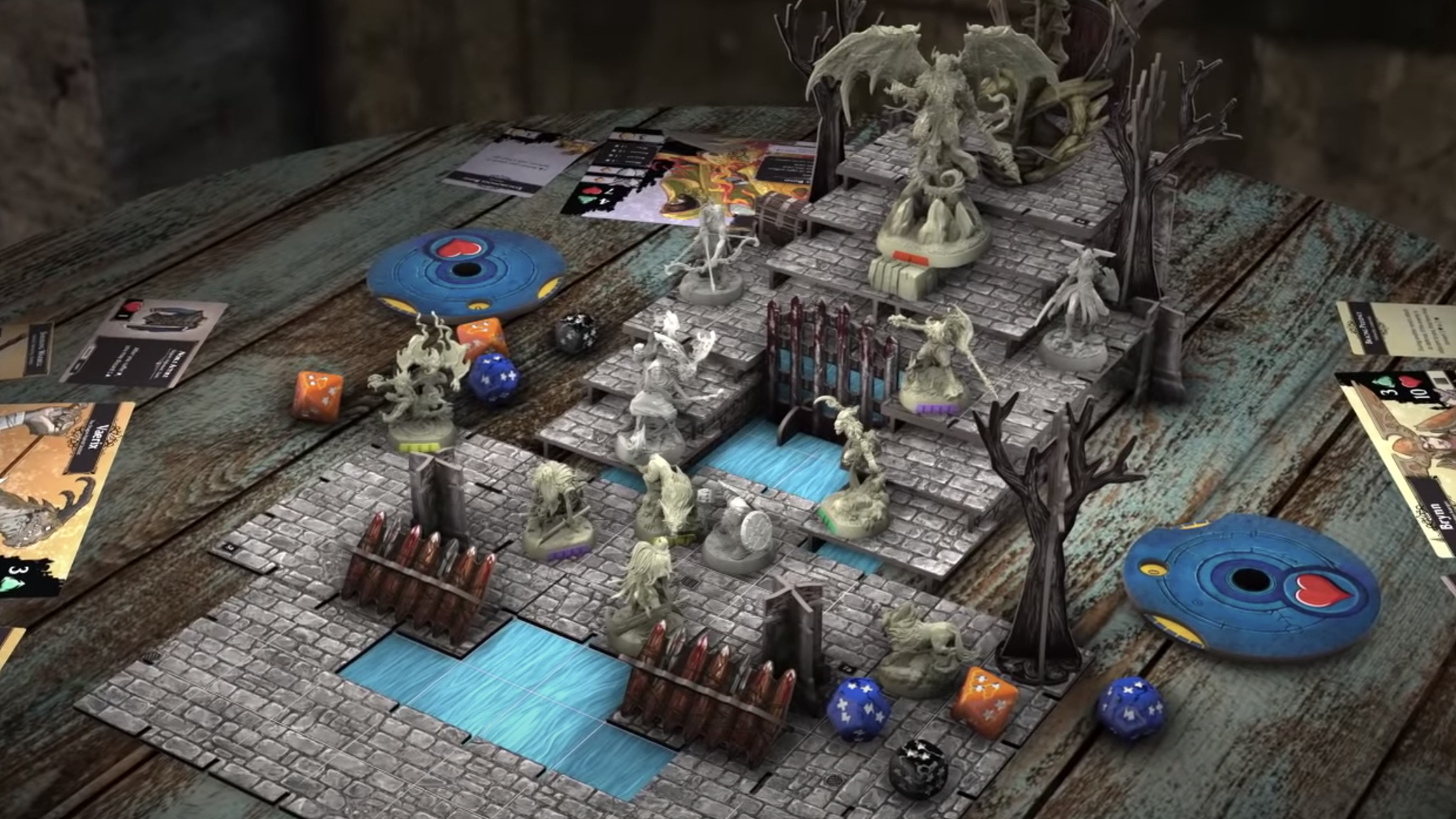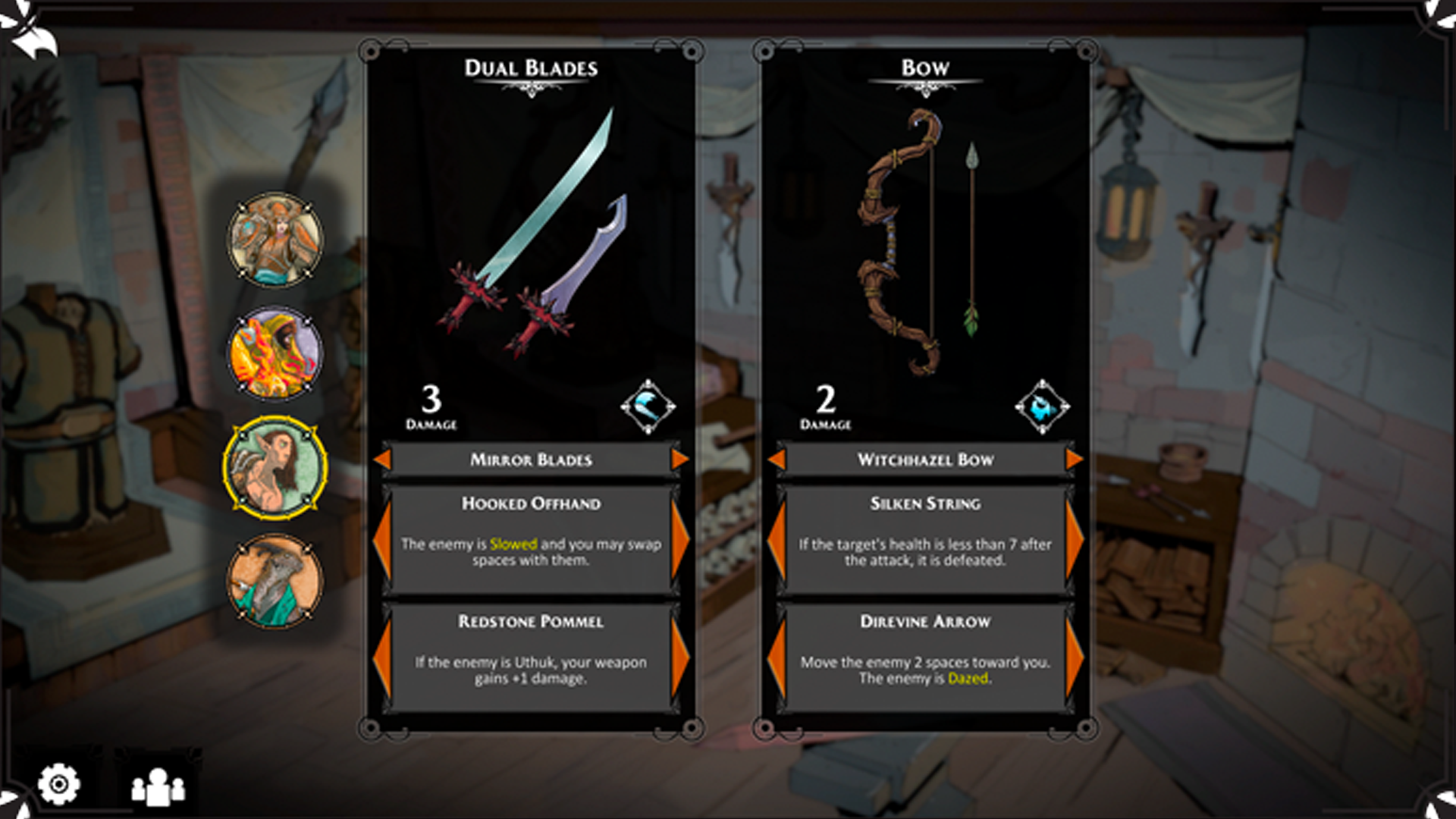How To Play Descent Journeys In The Dark
A new Descent game is finally happening. Only Descent: Legends of the Night isn't simply a third edition of beloved dungeon-crawler Journeys in the Nighttime - information technology's a brand new direction for the fantasy franchise, built on top of an aggressive new companion app and a fully co-op narrative experience.
Arriving almost a full decade subsequently Journeys in the Nighttime's latest second edition released in 2012, Legends of the Night is billed as simply the get-go part of a planned series - the core box'due south 16-mission Blood and Flame entrada is even labelled as 'Deed I' of a grander story.
Gone is Journeys in the Dark'southward all-versus-one setup and GM-similar overlord player, replaced by a newly mandatory companion app - a significant evolution from Journeys' optional Road to Legend companion - that players will demand to play and guide their characters through the connected storyline.
The app's narrative events and dynamic enemy AI combines with revamped gameplay on the table, too, with a new carte du jour-sleeve system for weapon customisation, a revised gainsay system and a box packed with paper-thin terrain to create 3D environments across multiple levels.
It's a bold, ambitious next footstep for the Descent series that's already stirred up discussion among fans over its app reliance, its explicit departure from Journeys in the Dark and its $175 request toll.
Ahead of Descent: Legends of the Dark's long-awaited release next month, I spoke with Fantasy Flight Games senior game designer Kara Centell-Dunk and game designer Brandon Perdue near bringing a fantasy classic back into a hobby saturated past dungeon-crawlers, the divisive decision to rely on a companion app, and that price tag.

Legends of the Dark has been described as beingness a brand new Descent title, rather than a third edition of Journeys in the Dark. Why was information technology important to make this distinction, and what does that mean in terms of its relationship and similarities to previous Descent games?
Brandon Perdue: Legends of the Night will let players once over again take on the roles of heroes in the realm of Terrinoth, and fans of previous Descent titles will recognize some of the characters, creatures, and factions that announced. But not only is Legends of the Dark congenital on new mechanics from the footing up, it also has what is, for us, an unprecedented amount of focus on telling a story and making that feel responsive to players' decisions and achievements. Non just tin can players make big decisions that will affect the hereafter of Terrinoth itself, but they'll too guide each of the six playable heroes on their own personal stories, and will get to cull how the heroes' journeying changes each of them.
Descent: Legends of the Nighttime didn't start by looking at Descent: Journeys in the Night. Information technology was always a game that had its own identity and goals.
Kara Centell-Douse: For me, if I'one thousand making a new edition of a game, my starting betoken is the previous game. Even if I terminate up choosing to radically depart from the original, information technology nevertheless forms the foundation of the design process. Descent: Legends of the Nighttime didn't start by looking at Descent: Journeys in the Dark. It was always a game that had its own identity and goals. Both Nathan and I started our careers by designing expansion content for Descent: Journeys in the Dark, and so we carried a lot of that experience over into designing Descent: Legends of the Dark. The two games share being tactical, grid-based dungeon-crawlers set in Terrinoth and starring heroes, but Legends embraces telling a more specific, co-operative hero-focused narrative and pushes app-use to create unique systems like crafting, hero feats that unlock skills and recipes and unique enemy behaviours, to proper noun just a few.

Journeys in the Dark 2E was released near x years agone. Why has a new Descent game taken so long to emerge?
Perdue: Kara can speak more fully to this considering she's been involved with Descent every bit a series far longer than I accept, but I call up in that location was a feeling that for a game to say Descent on the cover, it needed to be more than just a good dungeon-crawler; information technology needed to bring something new to the table.
Centell-Dunk: To Brandon'due south indicate, if there'due south going to exist a new Descent game, information technology has to come from a dandy idea and not just be for the sake of beingness made. Time is only 1 factor. 10 years as well sounds long ago if yous only focus on the Descent: Journeys in the Dark base game release, merely the co-op Road to Fable app content was released just four years ago, and it was pretty impactful.
When did Legends of the Dark begin evolution? What were the most pregnant changes from your original concept for the game, and why?
Centell-Dunk: Legends of the Dark got its earliest outset quondam in 2018. The great truth of making board games is that you're going to make about a hundred versions of your game as y'all go. Ane meaning change is that every quest used to be multiple maps/encounters. Ultimately, there were a handful of reasons we moved away from that, some of the bigger ones were: 1) private smaller maps had less to explore, 2) tearing downwards and building multiple maps takes time, 3) multiple encounters made every location and story have a similar structure. Now our quests are designed around what makes the experience for players the strongest, both narratively and mechanically. Some quests are one big dungeon yous uncover a tile or two at a time, while others brand thoughtful utilize of representing multiple locations as you play.
A major part of making Legends of the Dark was identifying early what kind of experience we idea wasn't already out in that location that people want.
Dungeon-crawlers have become one of the most popular genres on the tabletop, particularly in the years since Journeys in the Dark was released. Did you feel you had to go farther to ensure Legends of the Dark stood out in the crowded genre? What does it offer in terms of mechanics or experience that's new to dungeon-crawling?
Perdue: I think that was absolutely in our minds. At that place are a ton of different dungeon-crawlers out there at present that offer some really cool experiences, so a major part of making Legends of the Dark was identifying early what kind of experience we thought wasn't already out there that people desire, and thinking most what we could practice uniquely well.
Centell-Douse: Admittedly! It'southward not just dungeon-crawlers - there'due south a lot of great games coming out lately. Equally a histrion, I honey the choice and variety, and as a designer information technology makes me ask the same question: what am I doing to requite players something that they haven't seen before, or at least oasis't seen this manner?

In Legends of the Night, I dearest the menu flipping. Your hero, skill, and combat card are all double-sided, and each side has a different ability. When you play the game, you'll build up fatigue and conditions on your cards, and you tin articulate those by flipping them. And then deciding when and if to flip your cards is key—for example, do you keep the skill y'all want, but suffer poison damage each plow until y'all flip to clear it? I similar that it makes a rest/recovery mechanic an interesting tactical decision.
Descent: Legends of the Dark also has crafting, weapon customisation and its own custom, dynamic soundtrack. Each hero character has personal stakes in the story being told, and virtues they'll cull between that will impact their stories and mechanical moments in quests. Enemies accept impairment type weaknesses, different abilities, and tactics. There are even variations within enemy types, so in that location's not just the Bandit but also the Shadowalk Bandit and the Runeblade Bandit. Almost every piece of 3D terrain is interactable by default, so you tin climb the tree, mash a potion in the cauldron or get water from the well. And, of grade, Descent uses pillars and stairs to create multi-level maps.

Legends of the Dark's box includes a lot of 3D terrain. What was the importance of including 3D terrain, rather than conventional paper-thin tokens/tiles?
Perdue: So that depth and verticality isn't just for show: it matters in the gameplay, and it matters in the way we can build adventures. Many of the quests in Legends of the Dark simply couldn't exist washed with flat tokens because it'southward important that things tin be stacked or climbed or on summit of each other. The fact that information technology also makes the game expect actually awesome on your table is a prissy bonus, though.
Our terrain is hither to look pretty, yes, but also serve a mechanical purpose.
Centell-Dunk: Pillars and stairs create maps with levels and verticality. You might shoot arrows from the ramparts down on melee foes below, and those enemies tin can't hit yous back unless they take the stairs which might buy you a plow to set on them again. Other tokens cake line of sight—a function that's intuitive and clear when you encounter a tall bookshelf continuing next to a low table instead of ii flat tokens.
This question reminds me of plastic figures. Like, "Why include plastic figures instead of tokens in your game?" And the reply is similar to having plastic figures: for some it just looks better and is more than immersive than just having flat tokens do the work. But nosotros know that'southward not enough for anybody, which is why nosotros leaned into our 3D terrain whenever possible from a mechanical betoken of view. Our terrain is here to await pretty, aye, but also serve a mechanical purpose.
The box was appear with a rather significant RRP of $175. Exercise yous accept any concerns that the price may limit the game'southward appeal? Peculiarly in the wake of Kickstarter games of a similar price?
Centell-Douse: Before I made games, I worked retail and had very little money, so I know that price will ever be a limiting factor. I was pretty song about taking the price tag seriously during evolution - Legends of the Dark was already a really ambitious project, just I and others were always pushing to find means to add more content or meliorate upon the content we had already fabricated. Ultimately, though, I know value is going to be subjective.
It's difficult to communicate simply how much value the digital part of the game adds.
Perdue: Sure. We know people will look at Legends of the Nighttime next to other games with that sort of cost tag and ask if it is worth information technology. Communicating the value of the app content is always a challenge too; earlier players have gotten their hands on the content in the app, and seen the diverseness of scenarios and the depth of narrative, it'south hard to communicate but how much value the digital office of the game adds. Simply this app definitely goes beyond anything we've done with our previous games and I call back some people who might exist on the argue at present volition be really intrigued once they see what it's doing.

Journeys in the Dark received an optional companion app, Route to Legend, but Legends of the Nighttime makes the app mandatory. Why did yous determine what a fully app-powered experience was necessary this time around?
Making the app an indispensable part of Legends of the Night means nosotros could push this game in ways that nosotros could simply never do in a scenario book or a deck of cards.
Centell-Douse: Information technology was role of the foundation of this design idea. You know, we've washed some amazing piece of work with app-integration, and so one of the questions we posed was "What take we learned from app-integration and then far? Where tin can we improve or innovate with our apps?" We wanted to create an interactive story and tactical enemies without bogging players down—an app makes that possible.
Perdue: Our games with optional apps take to brand compromises to the fact that the game has to work without the app, and that'south always express a bit what nosotros can exercise with those experiences. Making the app an indispensable part of Legends of the Night ways we could button this game in means that we could merely never do in a scenario book or a deck of cards. The complexity of some of the logic this app is doing, and the number of things information technology is tracking to brand this experience responsive to players in means large and pocket-size, is beyond anything we could've accomplished without the app.

The app means that the game is fully co-op, as with Mansions' move from ane-versus-many in second edition. Is this a reflection of thespian interest in games with a GM or overlord-style role? Will time to come games similarly opt for co-op over competitive?
Perdue: I think information technology's more than specifically a reflection of actor interest in games that let players tell stories together and feel like they are going on these epic adventures and accept a lot of agency in the manner the saga unfolds at their gaming table. When we've tried to tell stories in competitive games similar Journeys in the Night or Imperial Assault, it oftentimes felt like getting to tell the story you wanted was the prize for winning, and that meant that someone at the table didn't become to tell the story they wanted. That's fine for games that are really about the tactics and outwitting your opponent with the story but as a garnish. But the story is the eye of Legends of the Nighttime, and we want everyone at the tabular array to be part of that together.
Centell-Dunk: In co-op I think there'southward more room for losses or failure to feel similar part of the tapestry of the story because it was completely in your hands. Whereas in a 1 v many losing a quest instead feels like something someone has done to you. In their story, our heroes can feel both victory and loss, but we want the losses to feel like function of their building fable, likewise.
I do think—and this is my perchance misguided opinion as a designer and as an inveterate game-player—that 1 versus many games are getting ripe for a comeback. I think the shift to co-op reflects a better agreement on what drives players away from one-v-many games, and that someone who looks at this and iterates on the one-5-many genre to address these concerns could make something actually, really cool.
How does Legends of the Dark's companion app build on Road to Legend, too as the companion apps for Mansions and Lord of the Rings: Journeys in Middle-earth? What does information technology practise that's new for app games equally a whole?
Centell-Dunk: Undo button! Information technology sounds like a small affair but I know people are going to be really excited nearly information technology.
One newer innovation is the fashion enemies work in this app. Each enemy has a unique ability when they're attacked and another unique ability when they actuate. When you fight bandits you accept to care that they're going to be pretty glace and run away later on you assail, and when you fight Uthuk berserkers you have to think more about positioning and so they tin can't assail 2 heroes during their activations.
In this app, you'll drag from your hero portrait to an enemy (to attack) or to an object (to collaborate), and so the app really knows who'due south doing what actions, which is entirely new. Information technology lets us do some nether the hood work - like having enemies target heroes who are doing a lot of harm to them - as well equally some overt narrative moments like how Brynn can find a favourite babyhood story among the books when she searches the bookshelf.

Perdue: What Kara mentioned in that location is really the biggest thing for me: what Legends of the Nighttime brings totally new is that we're now working with a specific cast of heroes who each accept their ain goals and hopes and flaws, and who each accept their ain story interwoven into the huge threat facing Terrinoth, and that lets the states go then much deeper into how players can engage with and bear on the story they're telling equally they play through the campaign.
Both Mansions of Madness and Journeys in Middle-world have received a mixture of digital-merely DLC and physical expansions. What are your plans for time to come Legends of the Dark releases?
Centell-Dunk: This is all in the realm of Nathan [Hajek, Legends of the Dark co-designer] and Brandon, who are standing work on Descent: Legends of the Dark. I'm just as excited to see what they brand as everyone else!
Perdue: The affair that excites me virtually about Legends of the Dark going forward is that this isn't a game line that resets for each product. People take noted that the game box says "Act I" on it, and that'due south not merely us trying to notice a cute alternative to saying "core set up". I kind of call up of the Act I campaign as the first "volume" in a series. The campaign has a plot that resolves and our heroes have their ain arcs that see resolution, but the story isn't over when the credits whorl.
Centell-Dunk: I joke that it'due south similar the movies. "Our heroes will return in Descent: Legends of the Night Act II."
How To Play Descent Journeys In The Dark,
Source: https://www.dicebreaker.com/games/descent-legends-of-the-dark/interview/descent-legends-of-the-dark-designer-interview
Posted by: eldridgeagaine.blogspot.com


0 Response to "How To Play Descent Journeys In The Dark"
Post a Comment